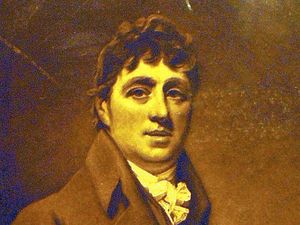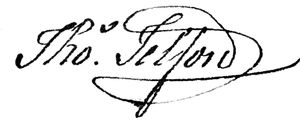From acqueducts to prisons: What did Thomas Telford do for us?
Thomas Telford, who died this day, September 2, in 1834, was a civil engineering giant who carved his name into Shropshire history.

And if you want to see his local legacy, look around. You can hardly miss a whole town named in his honour. Apart from that, there is lots of surviving stuff, here and there.
But if you want to see his most celebrated works, it's best to look elsewhere.
Among his showpieces which continue to speak of his greatness are the spectacular Pontcysyllte aqueduct, the magnificent suspension bridge over the Menai Straits, and the awesome Caledonian Canal.
Scroll down to see Thomas Telford's greatest hits
During his lifetime he was extraordinarily busy and hardworking – maybe being so driven was one reason why he never married, although his contemporaries found him genial and sociable, with a hearty laugh. His fingerprints are over a whole range of projects, big and small.
In a punning description which would not be out of place in a modern tabloid, the contemporary poet Robert Southey described him as “the Colossus of Roads”.
Yet he was far more than just a "roads and bridges" man, and the variety of his work was astonishing. For instance, several Shropshire churches are attributed to him. He even wrote poetry, which he loved.
Typically he was involved in several projects at once. Many of course were team efforts, so the level of his direct involvement varied, and in some cases there is a question mark over whether in his autobiography he gave full credit to the contributions of others.

His prowess was recognised nationally and internationally, and he played a large part in establishing civil engineering as a profession, and in 1820 was the founder president of the Institution of Civil Engineers.
His path to glory began in Shropshire, as it was during his time in the county that he really made a name for himself.
The impact he made was the launchpad for his later exploits.
Yet the story began in impoverished circumstances. He was born on August 9, 1757, in a cottage in Eskdale, Scotland, the son of a shepherd. His father died when he was only a few months old and he was brought up by his mother, Janet Jackson.
Continually he looked to improve himself, and had the gifts of being able to make friends and influence people. His attributes impressed people of high standing.
After learning his trade as a mason, he headed south to England in 1782, where he saw there were greater opportunities.
It was his good connections which brought him to Shropshire in 1786, when the wealthy William Pulteney, who was both Shrewsbury’s new MP and an old Scottish associate whom Telford knew, liked, and had worked for previously, sought him out when he was looking for someone to turn Shrewsbury Castle into his home.

According to the ICE, after his restoration Telford lived in the castle and practised from there as an architect.
His customary fortune smiled on him. Shropshire was looking for a county surveyor, and that role fell to Telford. As Shropshire’s first surveyor of public works – a post Telford held until his death – a whole new world of roads, bridges, and public buildings opened up.
Then there were those little incidents which cemented his growing reputation.
One often repeated anecdote is that the churchwardens of (old) St Chad's Church in Shrewsbury sought his help with the renovation of the dilapidated church.
He told them it was in danger of collapse, which is not what they wanted to hear, so they appointed a local stonemason to do some patching up.
Not long afterwards, the church collapsed, just as Telford had warned.
His notable works in Shropshire include Shrewsbury prison. The Dana was designed by J H Haycock, but in 1787 Telford was brought in to supervise construction. He met John Howard, the famous prison reformer, and remodelled the plans to create a more “humanitarian” institution.

It is not known exactly how far Telford deviated from the original plans, but the entrance to the jail is generally attributed to him, and carries a bust of Howard above it.
In 1792 he completed the stone Montford Bridge over the River Severn, the first bridge he built in the county, and in 1788 he carried out the first excavations in the site of the Roman city of Viroconium – now a major tourist attraction and heritage site at Wroxeter.
Modern motorists have a lot to thank him for.
Telford was in the vanguard of the roads revolution which more or less literally paved the way for our road transport system today. The Government turned to Telford to improve the road from Shrewsbury to Holyhead and, separately, that from Shrewsbury to London.
His improvements to Holyhead Road took place in stages between 1815 and 1829. Through North Wales it still follows the original line surveyed and chosen by Telford, and the road is considered a historic route.
In the Highlands of Scotland, Telford was responsible for about 1,200 miles of new or improved roads.

Abraham Darby III is given a place in the history books for just one bridge-building feat, that of building the world's first iron bridge, at Ironbridge. But Telford built 40 bridges in Shropshire alone, including iron bridges.
The only one of his iron bridges which survives in situ is Cantlop Bridge over Cound brook.
Original cast iron girders of another of his iron bridges, Cound Bridge, are now part of a pedestrian bridge in Hall Park Way, Telford. Cound Bridge once spanned the River Tern, but was dismantled in 1967 and its beams later kept at Blists Hill Museum waiting for a suitable opportunity to use them.
After his time in Shropshire he seems to have been a bit of a nomad, travelling to where the work was, although his base was in London, where he found rooms in a coffee house called, perhaps coincidentally, perhaps not, “The Salopian”, near Charing Cross.
He was to remain there for 21 years and became a fixture, and it was not until he was 64 that he had a home of his own, at 24 Abingdon Street, Westminster.

Eventually ill health slowed down even this workaholic, and he became increasingly deaf.
Even after death, he did not forget his Scottish roots, bequeathing £1,000 each to the ministers at Langholm and Westerkirk for the establishment of local libraries there.
In Shropshire, the greatest project of all bearing his name is one he had nothing to do with – the creation of a new town in the east of the county, which was given the name of Telford in 1968.
It was a name imposed by officialdom that nobody locally had suggested and at the time it's probable that a lot of people in the area had never heard of him. Indeed, works by Thomas Telford actually in Telford are very thin on the ground.
Nor was it the first town to be named in his honour. The small town of County Line in Pennsylvania changed its name to Telford in 1857 (or 1867, accounts vary), supposedly after the railroad station there was named after Telford, a strange accolade considering he never went to America.
One last twist. Thomas Telford was not born Thomas Telford. His father's name was John Telfer.
Thomas Telford's greatest hits
1 Pontcysyllte Aqueduct

Now a World Heritage Site, this is an enduring masterpiece, and one of the wonders of North Wales.
Today it continues to evoke awe, carrying the Llangollen Canal a dizzy 126ft over the wide River Dee valley, and travelling across it by narrowboat is an unforgettable experience, but not necessarily recommended for those with a fear of heights.
The aqueduct, which has 19 arches, was built between 1795 and 1805 and links Froncysyllte with the canal basin at Trevor. The canal runs through a 1007ft long iron trough.
The pronunciation of Pontcysyllte is “Pont-kus-ull-te,” which translated from Welsh into English simply means “connecting bridge.”
2 Holyhead Road

Telford arguably created the world's first motorway, or super highway, setting standards for the durability and quality of road construction which were far ahead of their time.
The government turned to Telford to improve the road from Shrewsbury to Holyhead and, separately, that from Shrewsbury to London – in essence, the road most of us now know as the A5.

The North Wales section brought with it difficult terrain and mountainous areas. Modern motorists still benefit from Telford's far sightedness today, as he would not tolerate steep slopes, and flattened the whole route through grading, levelling, and rerouting.
The 153-mile Shrewsbury to London route, basically following the old road built by the Romans, presented fewer challenges in terms of terrain, but with many turnpike trusts on the route, was a management nightmare.
3 The Caledonian Canal

A great monument to his genius.
It was conceived as a great inland waterway across Scotland, removing the need for ships to negotiate the hazardous sea route through the Pentland Firth.
Again, Telford had to contend with difficult and mountainous terrain.
There were immense engineering challenges, with work starting on the 60-mile canal in 1804. It includes 37 miles routed through natural lochs, the remainder being constructed channel.
When it was finished in 1822 the scheme was 12 years behind schedule and massively over budget.
Although not a commercial success, the dramatic scenery saw it become a tourist attraction, and it is today one of Scotland's tourism and heritage gems.
4 The Menai Suspension Bridge

In the view of many, this is his finest work, which turned Telford into a civil engineering superhero – and saved an untold number of lives.
Built between 1819 and 1826, it is more than 1,000ft long and 100ft above sea level, with a deck suspended by wrought iron cables.
Getting from the mainland to Anglesey had been a hazardous business by ferry, amid the tricky currents of the Menai Straits. Boats foundered or capsized, and lives were lost.
And with Ireland joining the UK through the Act of Union in 1800, the route to Holyhead became an important roadway as it was a journey politicians commuting to and from Ireland to parliament had to make.
Telford's iconic structure was the world's longest suspension bridge of its day
5 Wroxeter Roman City

Using an unusual team of labourers – prisoners – Telford embarked on an excavation at the site of the Roman city of Viroconium, which fascinated him.
Although his dig was somewhat crude by the standards of modern archaeological excavation, it made some major discoveries, and was to have a long-lasting benefit in that his work established Viroconium as a major archaeological site of national importance.
This of itself helped protect the site, which had been ravaged over time by people using it as a source of handy building stone, for future generations.
Today Viroconium, or Wroxeter Roman City, is one of the most important Roman sites in the UK.





